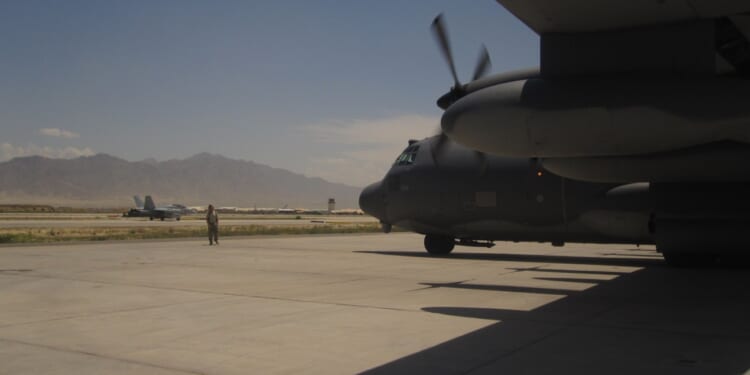A limited return to Afghanistan would confer immense advantages to Washington while triggering second-order geopolitical repercussions among its rivals.
President Donald Trump’s announcement that he intends to bring Bagram Air Base back under US control has set off fresh debate about America’s role in South and Central Asia. The air base has become a symbol of America’s 20-year war in Afghanistan. The US military abandoned the facility in July 2021 during a chaotic withdrawal that allowed the Taliban to sweep back into power the following month. If the Taliban returns the base, the US military will be entering a country that has undergone great changes since it withdrew. Will a return indicate US willingness to turn back the clock or embrace a new role in the region?
Bagram’s geography alone explains why it matters. The base sits about 1,000 miles from Tehran, just 400 miles from China’s restive Xinjiang province, and less than 800 miles from Pakistan’s Gwadar Port, a vital node in China’s Belt and Road Initiative. From this single location, Washington would gain a rare inland vantage point to monitor, and if necessary, counter both Iranian military ambitions and China’s growing economic and security footprint. By seeking to move back into Bagram, Trump is signaling that Afghanistan is no longer primarily a part of the US counterterrorism strategy. Instead, the country would be the central arena of great power competition.
Bagram’s history underscores strategic value. Built in the 1950s, it served as the Soviets’ central hub during the Soviet-Afghan War in the 1980s. Following the US intervention in 2001, Bagram experienced significant expansion. With two long runways, fortified hangars, sprawling logistics centers, and advanced surveillance systems, it became one of the most capable air bases anywhere outside the continental United States.
Unlike the US military bases in the Persian Gulf, which sit within easy range of Iranian missiles and are subject to the politics of host nations, Bagram could offer greater security and independence. Its position in the heart of Asia provides Washington with direct visibility over three critical theaters: eastern Iran, western China, and Russia’s sphere of influence in Central Asia.
Iran’s Angle
For Iran, the prospect of US forces returning to Bagram is deeply unsettling. Tehran has long focused on its westward defenses facing the Persian Gulf, Israel, and rival Arab states, leaving its eastern border comparatively exposed. Provinces like Sistan-Baluchestan have been persistently unstable and home to militant groups such as Jaish al-Adl that target Iranian forces. Before 2021, Tehran viewed the US mission in Bagram primarily as focused on counterterrorism and nation-building in Afghanistan, rather than as a platform for direct confrontation with Iran.
Today, a renewed US presence would come in a very different geopolitical climate, one defined by heightened US-Iran tensions and much closer US-Israel cooperation. With Bagram active, US drones and surveillance aircraft could easily track Islamic Revolutionary Guards Corps (IRGC) deployments, map smuggling networks, and monitor missile sites near the Afghan border. Even without strike aircraft, the base would force Tehran to stretch its defenses and seriously rethink how it allocates military resources.
Bagram also changes the dynamics of any future nuclear crisis. In the event of escalating tensions, the base would give Washington a secure platform for intelligence-gathering, special operations, and cyber units operating independently of Gulf bases, which might be politically constrained or vulnerable to Iranian missile strikes. It would not necessarily serve as the primary launch point for an attack, but its presence alone would complicate Iranian planning, creating a two-front problem: US naval and air power to the west and a land-based threat to the east.
The base also threatens Iran’s delicate relationship with the Taliban. Since 2021, Iran has built pragmatic ties with Afghanistan’s rulers, supplying fuel while seeking influence in western Afghanistan as a buffer against hostile Sunni militant groups. A renewed American presence at Bagram would put pressure on this arrangement, forcing the Taliban to balance their dealings with both Washington and Tehran.
It would also diminish Iran’s remaining ability to project power through Afghan Shia fighters, such as the Fatemiyoun Brigade, which Tehran once relied on in Syria. With Bashar al-Assad gone and the Syrian regime dismantled, Iran no longer has as many battlefields for its proxies. Some fighters have returned to Afghanistan or moved into Iraq, but Iran’s network of regional militias is weaker and more fragmented than it was just a few years ago.
China’s Perspective
While Iran may pose an immediate regional concern, China represents a broader, long-term rival. Beijing views Afghanistan and Pakistan as crucial to its Belt and Road Initiative, particularly through the China-Pakistan Economic Corridor (CPEC), which connects Xinjiang to the Arabian Sea. In August 2025, China and the Taliban held talks aimed at deepening cooperation in mining operations and formally joining the Belt and Road Initiative (BRI). At just under 800 miles from Bagram, Gwadar’s location gives it outsized strategic importance. For China, the port provides direct access to the Arabian Sea and a route that bypasses vulnerable chokepoints, such as the Strait of Malacca.
A fully functioning Bagram puts US eyes directly on these plans. From there, American forces could track Chinese security operations in Xinjiang, follow the construction of new infrastructure, and monitor Gwadar port and the surrounding road and rail networks. This level of visibility would provide Washington with valuable insight into how Beijing integrates commercial projects with its military and strategic objectives. Even without direct confrontation, the presence of US forces would compel China to spend more to secure its interests.
From this same vantage point, US forces could also track how Tehran and Beijing are deepening their ties. The 25-year agreement they signed in 2021 is often portrayed as a blueprint for expanded economic and security cooperation, but many of its terms remain vague. As Iran grows more reliant on China under the weight of sanctions and political isolation, Bagram’s presence would allow Washington to observe these flows, and, if necessary, to disrupt them before they harden into long-term alignments.
Russia Sees a Threat
One of the most dramatic shifts in the region came this summer when Russia formally recognized the Taliban government, the first country to do so. Earlier in April, Russia removed the Taliban from its list of banned terrorist organizations. These steps give Moscow enormous influence over Kabul. Recognition grants the Taliban diplomatic legitimacy and access to trade and development deals. It also gives Moscow the option to revoke recognition if Kabul tilts too far toward Washington.
Russia’s leverage extends beyond diplomacy. Afghanistan heavily relies on northern trade routes and fuel supplies that pass through Russia or its allied countries within the Collective Security Treaty Organization. Moscow can squeeze these lifelines to apply economic pressure. It also positions itself as a security guarantor. Russia sees the Islamic State Khorasan Province (ISKP) group as one of the most dangerous threats to Central Asia and its own southern regions. ISKP has carried out deadly attacks, including strikes on Russian and Chinese nationals within and outside Afghanistan.
Despite the threat ISKP poses, Moscow can still benefit from the instability the terror group creates, especially if the US military returns to Bagram. If the group attacks US convoys or targets near the air base, Russia will point to those incidents as evidence that Washington’s return is fueling violence. This narrative allows Moscow to present itself as a stabilizing force while undermining US legitimacy, all without ever aiding the very extremists it fears.
If Washington moves ahead with Bagram, Moscow is likely to respond in stages. Diplomatically, it will seek to rally China and Iran, and may try to influence Pakistan through Beijing, though it cannot necessarily count on Islamabad’s full support. Russia will rely on CSTO allies, such as Tajikistan, and attempt to influence non-member neighbors, like Uzbekistan, to limit American overflights and logistical access. Tashkent’s focus on stability and trade through Afghanistan, however, makes it unlikely to align with Moscow, creating room for friction.
If reconstruction of the base begins, Russia could quietly encourage Taliban factions opposed to US cooperation. This move risks clashing with Uzbekistan’s priority of maintaining a cohesive Taliban government to contain ISKP and protect its infrastructure projects. Cyber operations and disinformation campaigns would likely accompany these efforts, portraying Washington as reckless and unwelcome. At the same time, Moscow is reinforcing its military posture, upgrading its 201st base in Tajikistan, and conducting large CSTO exercises near the Afghan border.
India Reacts with Caution
India’s reaction will be cautious. While India fears Pakistani and Chinese influence, it is also in a trade dispute with Washington over tariffs. Publicly, New Delhi is unlikely to endorse the US move. Privately, it may share intelligence and quietly welcome anything that checks Beijing’s reach. India will attempt to hedge, maintaining channels of communication with both Washington and Beijing.
Rebuilding and Maintaining Bagram Won’t Be Easy
Even with Taliban cooperation, bringing Bagram back online would take time. The first step would be to secure the area and carry out basic surveys, a process that could last anywhere from two to six weeks, depending on security conditions and how much of the site remains intact. Repairing runways and restoring essential services, such as power and fuel, requires an additional two to three months. Some limited drone and surveillance activity could begin earlier, but it would likely take three to four months for a reliable intelligence presence to be established.
Setting up a modest, light-footprint base could take about six months if everything proceeds smoothly. Expanding it into a fully operational hub with fighter aircraft, logistics facilities, and munitions storage would be a longer effort, likely eight to 12 months or more. During this entire period, Russia, China, and Iran would have numerous opportunities to interfere, whether overtly or covertly, to slow or complicate the process.
The risks are high. Taliban factions could come to blows over the decision, leading to sabotage or leaks. Russia and Iran might covertly back Taliban hard-liners while blaming Washington for any instability caused by ISKP. China could respond by strengthening its security partnership with Pakistan or using economic pressure to constrain US actions. At home, Americans remain wary of a return to Afghanistan after the painful 2021 withdrawal.
Trump’s move to reclaim Bagram is a gamble. It signals that the United States wants to stay in the Eurasian game, even as rivals coordinate to shut it out. For Iran, it creates a new eastern front and forces a reassessment of its security strategy. For China, it threatens critical trade corridors and strategic projects. For Russia, it represents an unwelcome US foothold in a region Moscow considers its backyard, and one it now claims to manage through its recognition of the Taliban. India will watch carefully, seeking to protect its interests without alienating either side.
The new Bagram won’t just be a base for counterrorism operations; rather, it would shape the balance of power across Eurasia. Whether it becomes a valuable asset or a dangerous flashpoint will depend on how skillfully Washington navigates the regional web of rivalries. In the era of multipolar competition, Bagram’s second act will test not only America’s military reach but also its diplomacy and political resolve.
About the Author: Fatemeh Aman
Fatemeh Aman has written on Iranian, Afghan, and broader Middle East affairs for over 25 years and advised US and non-governmental officials. A former non-resident fellow at the Middle East Institute and senior fellow at the Atlantic Council, a writer, producer, and anchor at Voice of America, and a correspondent at Radio Free Europe/Radio Liberty, her work has appeared in Jane’s Islamic Affairs Analyst, Jane’s Intelligence Review, and the Stimson Center’s Middle East Perspectives. Follow her on X: @FatemehAman.
Image: Samantha Gassman / Shutterstock.com.


















